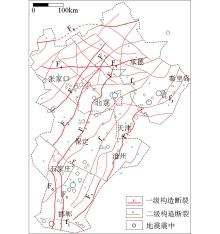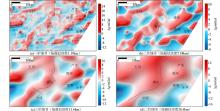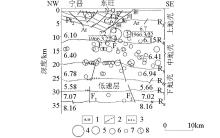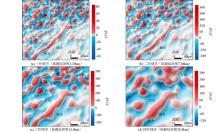|
|
|
| Interpretation of Hebei fault system and seismogeological structure based on gravity and magnetic data |
| Fei FANG |
| Hebei Earthquake Agency,Shijiazhuang 050021,China |
|
|
|
|
Abstract Hebei Province is one of the major areas where strong earthquakes occur in China, and the study of seismic structures in this area is of great significance to the understanding of earthquake disasters. Based on the 1:200 000 regional gravity and 1:200 000~1:50 000 aeromagnetic data, the fault system in Hebei Province is systematically studied by using the wavelet multi-scale fault analysis method, and applied to seismological structure analysis. The characteristics of the seismogenic faults of the 1966 Xingtai M7.2,1976 Tangshan M7.8 and 1679 Sanhe—Pinggu M8 earthquake are emphatically analyzed. It is found that the shallow faults of Xinhe fault, Tangshan fault and Xiadian fault are closely related to the deep faults. The plane position of shallow faults overlapped with the deep faults of the Xingtai M7.2 earthquake. The Xingtai M7.2 earthquake is the result of the joint action of the lower deep faults and the shallow Xinhe fault. It is concluded that the processing and interpretation of gravity and aeromagnetic data is an effective, fast and economical method for studying seismogeological structures, which can provide important information for the study of Seismogeological structures.
|
|
Received: 25 November 2019
Published: 24 June 2020
|
|
|
|
|
|

|
Bouguer gravity anomaly in Hebei Province and Beijing
|

|
Residual gravity anomaly in Hebei Province and Beijing
|

|
Aeromagnetic ΔT anomaly in Hebei Province and Beijing
|

|
Polarized magnetic anomaly in Hebei Province and Beijing
|

|
Recognition of geological body boundary by wavelet modulus maximum
|

|
Comparison of other boundary recognition methods(The black box in the picture is the boundary of the model)
|

|
Wavelet fracture analysis of gravity anomalies in Hebei Province and Beijing
(a), (b), (c) and (d) are the projections of 45°, 135°, 90° and 0° of the second-order details of wavelet
|

|
Wavelet fracture analysis of aeromagnetic anomalies in Hebei province and Beijing
Note: (a), (b), (c) and (d) are the projections of 45°, 135°, 90° and 0° of the second-order details of wavelet
|

|
Fault systems interpreted from gravity and magnetic data in Hebei Province and Beijing
|

|
Wavelet analysis of gravity anomalies
|

|
Tangshan gravity wavelet analysis( the red line in the figure is Tangshan fault)
|

|
Fault and epicenter distribution of strong earthquakes in southern sub-depression of Shulu fault basin
|

|
Petroleum seismic exploration and artificial seismic sounding results of Xinhe fault
|

|
Wavelet analysis of aeromagnetic anomalies in Sanhe-Pinggu(the red line in the figure is Xiadian fracture)
|
| [1] |
杨理华, 赵喜柱, 靳雅敏, 等. 河北省地震构造[J]. 华北地震科学, 1985,3(1):20-27.
|
| [1] |
Yang L H, Zhao X Z, Jin Y M, et al. Seismic structure of Hebei Province[J]. North China Earthquake Sciences, 1985,3(1):20-27.
|
| [2] |
黄汲清, 任纪舜, 姜春发, 等. 中国大地构造及其演化[M]. 北京: 科学出版社, 1983: 101-107.
|
| [2] |
Huang J Q, Ren J S, Jiang C F, et al. Geotectonic evolution of China[M]. Beijing: Beijing Science Press, 1983: 101-107.
|
| [3] |
马宗晋. 活动构造基础与工程地震[M]. 北京: 地震出版社, 1992: 20-36.
|
| [3] |
Ma Z J. Active structural foundation and engineering earthquake[M]. Beijing: Seismological Press, 1992; 20-36.
|
| [4] |
张亚东, 董杰, 肖金平. 河北省地质构造重力推断解释[J]. 物探与化探, 2011,35(2):5-10.
|
| [4] |
Zhang Y D, Dong J, Xiao J P. Gravity deduction and interpretation of geological structure in Hebei province[J]. Geophysical and Geochemical Exploration, 2011,35(2):5-10.
|
| [5] |
李文广, 施兴, 王德启, 等. 河北省航磁局部异常的形成因素及与成矿的关系[J]. 物探与化探, 2010,34(6):791-794.
|
| [5] |
Li W G, Shi X, Wang Q D, et al. The relationship between local aeromagnetic anomaly characteristic and mineralization in Hebei province[J]. Geophysical and Geochemical Exploration, 2010,34(6):791-794.
|
| [6] |
施兴, 彭朝晖, 潘佩璋. 河北省航磁资料的研究程度与找矿潜力分析[J]. 物探与化探, 2009,33(4):374-388.
|
| [6] |
Shi X, Peng Z H, Pan P Z. Analysis on the research degree and prospecting potential of aeromagnetic data in Hebei Province[J]. Geophysical and Geochemical Exploration, 2009,33(4):374-388.
|
| [7] |
邵时雄, 安仲元, 韩书华. 河北平原新构造运动主要特征分析[J]. 海洋地质与第四纪地质, 1984,44(4):67-77.
|
| [7] |
Shao S X, An Z Y, Han S H. An analysis of major neotectonics features of Hebei plain[J]. Marine Geology & Quaternary Geology, 1984,44(4):67-77.
|
| [8] |
熊盛青, 杨海, 丁燕云, 等. 中国航磁大地构造单元划分[J]. 中国地质, 2018,45(4):658-680.
|
| [8] |
Xiong S Q, Yang H, Ding Y Y, et al. Subdivision of tectonic units in China based on aeromagnetic data[J]. Chinese Geology, 2018,45(4):658-680.
|
| [9] |
Hood P, Mcclure D J. Gradient measurements in ground magnetic prospecting[J]. Geophysics, 1965,30(3):403-410.
|
| [10] |
Nabighian M N, Misac N. The analytic signal of two-dimensional magnetic bodies with polygonal cross-section:Its properties and use for automated anomaly interpretation[J]. Geophysics, 1972,37(3):507-517.
|
| [11] |
Cordell L. Gravimetric expression of graben faulting in Santa Fe Country and the Espanola Basin, New Mexico[J] Science, 2014,192(4234):43.

|
| [12] |
Hugh G M, Vijay S. Potential field tilt—a new concept for location of potential field sources[J]. 1994,32(2-3):213-217.
|
| [13] |
Wijns C, Perez C, Kowalczyk P. Theta map: Edge detection in magnetic data[J]. Geophysics, 2005,70(4):39-43.
|
| [14] |
Maurizio F, Tatiana Q. Wavelet analysis for the regional-residual and local separation of potential field anomalies[J]. Geophysical Prospecting, 1998,46(5):507-525.
|
| [15] |
Ucan O N, Seker S, Albora A M, et al. Separation of magnetic fields in geophysical studies using a 2-D multi-resolution Wavelet analysis approach[J]. Journal of the balkan geophysical society, 2000,3(3):53-58.
|
| [16] |
Ridsdill S T. Separating aeromagnetic anomalies using wavelet matched filters[J]. Seg Technical Program Expanded Abstracts, 1999,17(1):2092.
|
| [17] |
Mallat S. 杨力华. 信号处理的小波导引[M]. 北京: 机械工业出版社, 2002.
|
| [17] |
Mallat S, Yang L H. Small waveguide guide for signal processing[M]. Beijing: China Machine Press, 2002.
|
| [18] |
李世雄, 刘家琦. 小波变换与反演数学基础[M]. 北京: 地质出版社, 1994.
|
| [18] |
Li S X, Liu J Q. Wavelet transform and mathematical basis of inversion[M]. Beijing: Geology Press, 1984.
|
| [19] |
秦前清, 杨宗凯. 实用小波分析[M]. 西安: 西安电子科技大学出版社, 1994.
|
| [19] |
Qin Q Q, Yang Z K. Practical wavelet analysis [M]. Xi'an: Xidian University Press, 1994.
|
| [20] |
刘天佑. 位场勘探数据处理新方法[M]. 北京: 科学出版社, 2007.
|
| [20] |
Liu T Y. A new data processing method for potential field exploration[M]. Beijing: Science Press, 2007.
|
| [21] |
杨宇山, 李媛媛, 刘天佑. 小波细节的微分特征及其在重力场断裂分析中的应用[J]. 地质与勘探, 2003,39(1):41-44.
|
| [21] |
Yang Y S, Li Y Y, Liu T Y. Differential characteristics of wavelet details and its application in gravity fracture analysis[J]. Geology and Prospecting, 2003,39(1):41-44.
|
| [22] |
张先, 赵丽, 刘天佑, 等. 北京地区航磁异常的多尺度分解及断裂研究[J]. 地震学报, 28(5):504-512.
|
| [22] |
Zhang X, Zhao L, Liu T Y, et al. Multiscale decomposition and fracture study of aeromagnetic anomalies in Beijing area[J]. Acta Seismologica Sinica, 28(5):504-512.
|
| [23] |
王景明. 华北地震灾害与对策[M]. 北京: 地震出版社,1993:1- 12, 24-36.
|
| [23] |
Wang J M. Earthquake disaster and Countermeasures in North China[M]. Beijing: Seismological Press, 1993: 1- 12, 24-36.
|
| [24] |
王景明. 华北地震灾害与对策[M]. 北京: 地震出版社, 1993: 1- 12, 24-36.
|
| [24] |
Wang J M. Earthquake disaster and countermeasures in North China[M]. Beijing: Seismological Press, 1993: 1- 12, 24-36.
|
| [25] |
张四昌, 赵军, 刁桂苓. 华北地区震源断层与深浅构造关系的初步研究[J]. 华北地震科学, 1995,13(3):1-10.
|
| [25] |
Zhang S C, Zhao J, Diao G L. A preliminary study on the relationship between focal faults and deep shallow structures in North China[J]. North China Earthquake Sciences, 1995,13(3):1-10.
|
| [26] |
徐杰, 牛娈芳. 唐山—河间—磁县新生地震构造带[J]. 地震地质, 1996,18(3):193-198.

|
| [26] |
Xu J, Niu L F. Tangshan—Hejian—Cixian Cenozoic seismic structural belt[J]. Seismology and Geology, 1996,18(3):193-198.

|
| [27] |
徐杰, 方仲景, 杨理华. 1966年邢台7.2级地震的构造背景和发震构造[J]. 地震地质, 1988,10(4):51-59.

|
| [27] |
Xu J, Fang J J, Yang L H. The tectonic setting and seismogenic structure of the 1966 Xingtai Ms7.2 earthquake[J]. Seismology and Geology, 1988,10(4):51-59.

|
| [28] |
高战武, 徐杰, 宋长青, 等. 华北沧东断裂的构造特征[J]. 地震地质, 2000,22(4):395-404.

|
| [28] |
Gao Z W, Xu J, Song C Q, et al. Structural characters of the Cangdong fault in North China[J]. Seismology and Geology, 2000,22(4):395-404.

|
| [29] |
刘保金, 曲国胜, 孙铭心, 等. 唐山地震区地壳结构和构造:深地震反射剖面结果[J]. 地震地质, 2011,33(4):901-912.

|
| [29] |
Liu B J, Qu G S, Sun M X, et al. Crustal structures and tectonics of Tangshan earthquake area: Results from deep seismic reflection profiling[J]. Seismology and Geology, 2011,33(4):901-912.

|
| [30] |
河北省地震局. 一九六六年邢台地震[M]. 北京: 地震出版社, 1986.
|
| [30] |
Hebei Earthquake Agency. 1966 Xingtai earthquake[M]. Beijing: Seismological Press, 1986.
|
| [31] |
徐锡伟, 于贵华, 王峰, 等. 1966年邢台地震群的发震构造模型——新生断层形成?先存活断层摩擦粘滑?[J]. 中国地震, 2000,16(4):364-378.
|
| [31] |
Xu X W, Yu G H, Wang F, et al. Seismogenic model for the 1966 Xingtai Earthquakes ——nucleationof new-born fault or strick-slip of pre-existing fault?[J]. Earthquake Research in China, 2000,16(4):364-378.
|
| [32] |
江娃利. 有关华北平原强震发震构造问题的讨论[J]. 中国地震, 2006,22(2):135-141.
|
| [32] |
Jiang W L. Discussion on problems for seismo-tectonics of Strong Earthquakes in the North China Plian[J]. Earthquake Research in China, 2006,22(2):135-141.
|
| [33] |
刘保金, 张先康, 陈颙, 等. 三河一平谷8.0级地震区地壳结构和活动断裂研究——利用单次覆盖深反射和浅层地震剖面[J]. 地球物理学报, 2011,54(5):1251-1259.

|
| [33] |
Liu B J, Zhang X K, Chen Y, et al. Research on crustal structure and active fault in the Sanhe-Pinggu Earthquake (M8.0) Zone based on single-fold deep seismic reflection and shallow seismic reflection profiling[J]. China Journal of Geophysics, 2011,54(5):1251-1259.
|
| [34] |
张先, 张先康, 刘敏, 等. 华北地区8级大震的深部构造特征及地震成因的探讨[J]. 地震学报, 2003,25(2):136-142.
|
| [34] |
Zhang X, Zhang X K, Liu M, et al. Deep structural characteristics and seismogenesis of the M=8.0 earthquakes in North China[J]. Acta Seismologica Sinica, 2003,25(2):136-142.
|
| [1] |
CHEN Da-Lei, WANG Run-Sheng, HE Chun-Yan, WANG Xun, YIN Zhao-Kai, YU Jia-Bin. Application of integrated geophysical exploration in deep spatial structures: A case study of Jiaodong gold ore concentration area[J]. Geophysical and Geochemical Exploration, 2022, 46(1): 70-77. |
| [2] |
YANG Jing, GUO Liang-Hui. A modified interpolation-iteration method for gravity anomaly continuation from undulating surface to plane[J]. Geophysical and Geochemical Exploration, 2022, 46(1): 123-129. |
|
|
|
|
